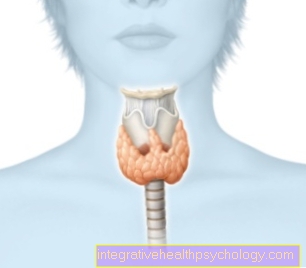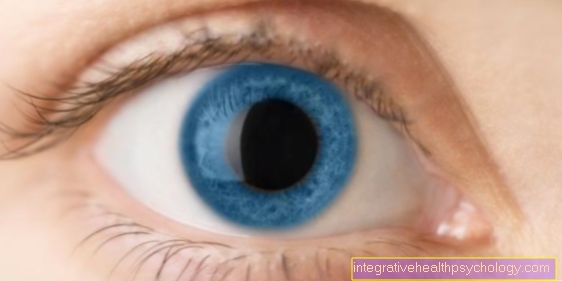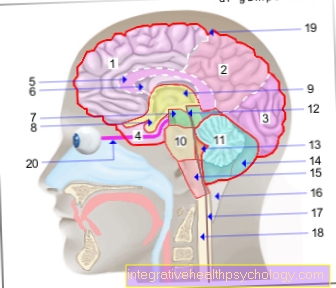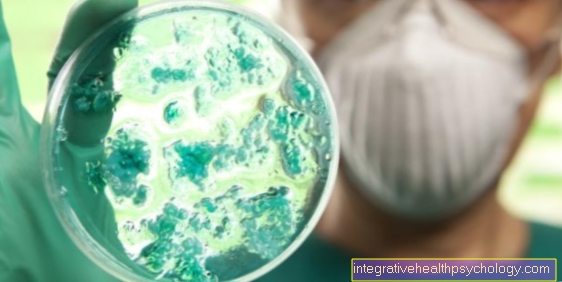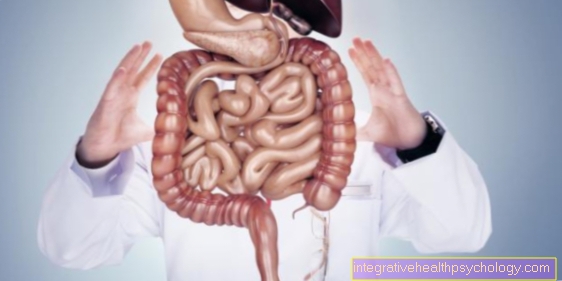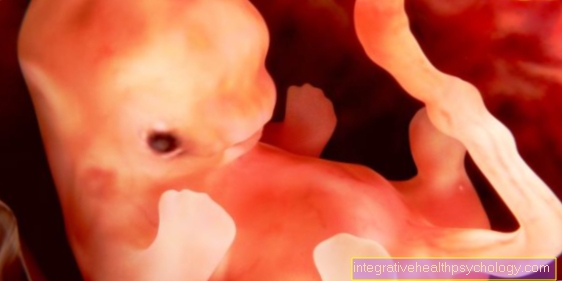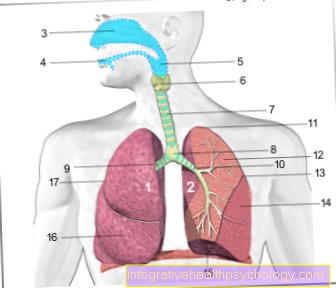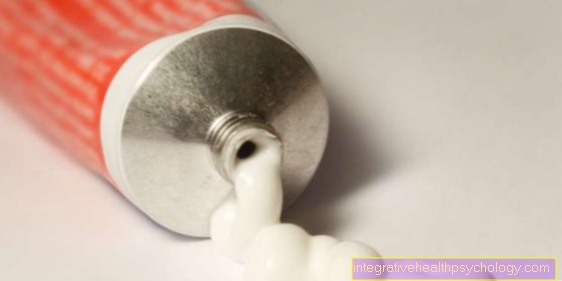Myocarditis
causes
The causes of inflammation of the heart muscle (myocarditis) can be varied. An infection of the muscle layer of the heart can be caused by microorganisms such as bacteria or viruses, in which case it is what is known as infectious myocarditis. However, if substances that are toxic to the body come into question as the cause, they are referred to as toxic form.

A cold can result from both a viral and bacterial infection.
This infection can also reach the heart muscles and lead to an inflammation called myocarditis. An estimated 1 to 5% of all viral infections are associated with cardiac involvement. The most common viral pathogens are the Coxsackie virus. But the parvovirus B19, which causes rubella, can also cause myocarditis.
Likewise the human herpes virus and adenoviruses. The most common bacterial triggers are Corynebacterium diphtheriae (pathogen causing the disease diptheria), Borrelia burgdorferie (often transmitted by ticks) and β-hemolytic streptococci.
Post-flu myocarditis
Post-flu myocarditis is similar to having a cold. Possible triggering pathogens can be viruses as well as bacteria, whereby an infection by viruses is much more common.
Coxsackieviruses are particularly common in people with myocarditis. Other pathogens mainly affect those who suffer from immunodeficiency. A flu-like infection can spread to the entire body more quickly and thus damage the heart. Due to the severity of the complications of myocarditis, you should avoid any physical activity for at least a week if you have a flu
In this context, the most common reason for this form of alcohol consumption, the intake of heavy metals and the possibility of side effects from drugs such as chemotherapeutic agents for cancer, sleeping pills and anesthetics (barbiturates) or psychotropic drugs should be mentioned. Furthermore, an already existing autoimmune disease can be responsible for an inflammation of the heart muscle. Diseases such as sarcoid, systemic lupus erythematosus, scleroderma, or vascular inflammation (Vasculitis), in which the human immune system is directed against the body's own structures, in some cases encroach on the heart muscle and cause the destruction of the muscle tissue as part of an inflammatory reaction. Finally, the idiopathic form of myocarditis should be mentioned, in which there is no recognizable cause for the inflammatory process.
Effects
Microorganisms such as viruses and bacteria are able to damage the heart muscle via different points of attack, which ultimately causes a heart muscle malfunction. On the one hand, the pathogen can migrate into the muscle tissue and initiate the inflammatory process directly on site. At the molecular level, tissue and possible vascular damage in the heart is initially caused by the virus. The immune system is then activated, the body's own defense cells migrate and initiate the destruction and elimination of the viral invader. During the inflammatory process, hormone-like substances are also released, which act as mediators between the immune cells (Cytokines). However, these have the disadvantage that they reduce the performance of the heart and have a negative impact on tissue structure. Viruses can act on the immune cells by increasing or reducing the activity of individual cell groups and ultimately changing the tissue structure through an imbalance in the inflammatory process. An alternative mechanism is the production of tissue-damaging toxins, which indirectly lead to cell destruction. In addition, some viruses are able to trigger a defense reaction against, for example, intrinsic proteins if they have structural similarities to virus proteins. In this respect, the pathological changes can continue even in the absence of the virus.
You might also be interested in: Myocarditis
Symptoms of myocarditis
The symptoms of myocarditis are as varied as they are unspecific. Myocarditis can take all possible forms between asymptomatic and fulminant (sudden, severe, rapid).
Since myocarditis is often related to an infection, symptoms such as coughing, runny nose, fever and headache are not uncommon. In addition, there are often unspecific complaints such as fatigue and a drop in performance.
Palpitations (noticeable palpitations or palpitations) are also noticeable. In addition, heart-specific symptoms are also noticeable. Especially when the pericardium, which surrounds the heart, is affected, pain in the chest area occurs. These are particularly noticeable when inhaling. Cardiac arrhythmias also occur. If the heart is affected not only temporarily but for a long time, it leads to heart failure (heart failure). This is also noticeable through tiredness, reduced performance and low resilience.
Difficulty breathing can also occur with little exertion or even at rest. Often times, water is stored in the legs (especially on the ankles). These deposits are also known as edema.
Read more on the topic: Symptoms of myocarditis
Viral and bacterial pathogens
In case of a infectious myocarditis get into developed countries most likely viruses in question. Mainly found in microbiological evidence Enteroviruses, especially Coxackie Viruses and ECHO viruses. Other pathogens like that are also important Parvovirus B19 as the causative agent of Ringlet rubella, Adenoviruses and Herpes viruses, especially that Human herpes virus six. They come less often HI virus and Cytomegaly virus (CMV) in question. Usually following infections that are localized elsewhere, such as the upper respiratory tract or the gastrointestinal tract, there is a low risk of spreading in the heart muscle. Possible Sources of infection through contact with faeces, contaminated hands, toys, drinking water and much more.
To the bacterial causers of myocarditis include the causative agent of diphtheria, tuberculosis, Lyme disease or Pneumococci. However are rather already immunocompromised people affected by bacterial myocarditis. Unicellular organisms (Protozoa) as the causative agent of the Chagas disease is found as the main cause in South America and therefore they hardly play a role in Europe. Parasites and Mould- or Yeasts are also able to cause such a clinical picture, but numerically they only make up a small proportion.
Chronic myocarditis
It is crucial for the progression and healing of a heart muscle inflammation that it remains (Persistence) or that Survival of the pathogen in the tissue. If viral genetic information (RNA) or virus components remain, the immune response and thus the Maintain inflammation. It is more likely to develop chronic coursewhich with Conversion of muscle tissue into connective tissue (Fibrosis) and within a few years becomes a Expansion of the heart chambers can lead. These would manifest themselves as typical symptoms of heart failure.
Usually the immune system eliminates the pathogen easily and it comes to one spontaneous, effective healing - the infection has no consequences. It is believed that a genetic susceptibility or susceptibility of the person affected clearly favors the transition to a chronic course.
Diagnosis of suspected myocarditis
Every medical diagnosis begins with the anamnesis. The above-mentioned symptoms are asked for here, and value is also placed on a possible trigger of the illness (cold, flu-like infection). The focus is then on the physical examination. Here, special attention is paid to water retention. These can be detected both in the legs and possibly in the lungs.
Arrhythmias can be diagnosed by listening to your heart. Heart murmurs occur particularly during the tension phase of the heart, the so-called systole. If the pericardium is also affected by the inflammation, a so-called Pericardial rub (Rubbing the two leaves of the pericardium together) can be heard.
Another diagnostic step is the EKG. Cardiac arrhythmias are the easiest to recognize here, and a possible localization of the heart problem can also be carried out. Usually, a blood sample is also examined in the laboratory. Heart-specific enzymes are used here.
But also searched for viruses or bacteria that could trigger it. Imaging (X-ray, cardiac ultrasound, cardiac MRI) can also be groundbreaking.
For the final confirmation of the diagnosis, a biopsy is taken from the heart muscles.
You might also be interested in: Diagnosis of myocarditis
What changes can be seen in the ECG?
The changes that show up in myocarditis in the ECG are just as diverse as the symptoms with which the disease makes itself felt. If a cardiac arrhythmia is present, this can be seen particularly well in the ECG. You can take the form of a simple Tachycardia (heartbeat too fast). But also a so-called arrhythmia can indicate a rhythm disturbance. This leads to additional tension in the heart chambers between normal heartbeats.
In the EKG, the heart's electrical currents are recorded at various positions. In this way, disturbances in the conduction and / or regression can be displayed and localized very well. Similar to a heart attack, a so-called ST segment depression or T-wave negativity can also occur. These also indicate a disturbed excitation conduction.
If a part of the heart is no longer reached by the electrical excitation, one speaks of a bundle branch block. A left bundle branch block means that the left ventricle no longer receives electrical signals and therefore contracts in an uncoordinated manner and no longer.
How do the laboratory values on myocarditis change?
Various values in the blood are changed during myocarditis. On the one hand, this includes indicators that indicate cardiac damage, on the other hand, the triggers of the disease can often be found in the laboratory test.
Heart enzymes belong to the heart-specific blood values. These are released into the bloodstream when heart cells are damaged. These are the CK, the CK-MB and the troponin-T. In addition to these rather unspecific heart markers, the BNP can also be increased, which can indicate the onset of heart failure.
If a virus infection comes into consideration as a trigger, it is worth performing a virus serology, as the pathogen can often be found in the blood.
MRI of the heart in myocarditis
If a heart muscle inflammation is suspected, X-rays and cardiac ultrasound are the imaging methods of choice. Both can be carried out quickly and can provide initial indications of myocarditis.
If the suspicion of myocarditis is confirmed in the examinations, an MRI (magnetic resonance imaging) of the heart should be performed. The entire recording is composed of many individual images that are recorded on different levels. As a result, a virtual three-dimensional reconstruction of the heart is even possible with modern technology. The myocarditis can be diagnosed with the help of the MRI images, and the course of the disease can be monitored through multiple images.
What does the therapy look like for heart muscle inflammation?
The therapy initially depends on the severity of the myocarditis. Usually the symptoms (symptomatic therapy) and the causes (causal therapy) of the myocarditis are treated in parallel.
The symptomatic therapy includes, first and foremost, physical restraint and a temporary refusal to exercise.Painkillers may also be prescribed for chest pain. Depending on the severity of the myocarditis, this treatment can be carried out at home or in a hospital (possibly with monitor monitoring).
The causal therapy is directed against the triggering germs and must be adapted depending on the pathogen. Fungal diseases are treated with so-called antimycotics.
Antibiotics help if you have a bacterial infection. These have to be adjusted depending on the type of bacteria. Antiviral drugs are usually used in the event of a virus disease, but many of the drugs can only be used in the context of studies. The situation is similar with immunosuppressive drugs. These are needed when myocarditis is the result of an autoimmune process (the body directs its immune defense against itself).
Complications such as heart failure are treated with appropriate medication (water tablets). A heart transplant may be necessary in the most severe cases.
When do antibiotics help?
Antibiotics are all types of drugs that are specifically effective against bacteria and thus also against bacterial infections. Depending on the type of bacteria, different groups of antibiotics are used.
Antibiotic therapy only makes sense against myocarditis if a bacterial infection is the cause of the disease.
Antibiotics do not help against viruses or autoimmune processes (in which the immune system attacks the body). However, if there is a bacterial disease, the infection can be treated quickly and specifically with the help of various antibiotics, so that possible complications are minimized and the duration of myocarditis is significantly shortened.
Duration of myocarditis
The duration of myocarditis depends on various factors. The age and general health of the person affected play a particularly important role.
Younger people tend to recover faster than older people. Whose heart has already been damaged by previous illnesses takes longer to recover than an otherwise healthy heart. The extent of cardiac muscle damage also plays a role. Myocarditis without complications usually heals after about five to six weeks.
However, if there are disruptive factors, the recovery process can take a period of two to three months. A great danger with myocarditis is the chronicity of the disease or chronic suffering from the consequences of the infection. Complications such as cardiac arrhythmias can regress within a short time, but they can also last for a lifetime. The myocarditis goes into a dilated cardiomyopathy over, the heart chambers are enlarged, which causes a lower output of the heart. This condition can also turn into a chronic disease. The same applies to heart failure (including heart failure), which often accompanies those affected until the end of their lives.
Read more on the topic: Duration of an inflammation of the heart muscle
When can I do sports again afterwards?
Myocarditis can lead to sudden heart failure during exercise, often fatal. Therefore, a sports ban must be strictly observed. Before the physical activity can be started again, a detailed examination must be carried out by the attending physician. This usually includes laboratory tests, as well as a physical exam and an ultrasound of the heart.
Only when an existing functional restriction of the left ventricle can be safely ruled out, sport should be resumed. Due to the severity of the disease, a break of around 3 months is not uncommon.
You might also be interested in: Cardiac muscle inflammation from exercise
What can be the consequences of myocarditis?
Myocarditis results in inflammation of the heart muscles, which often affects the conduction system. This can lead to acute cardiac arrhythmias. In addition, individual parts of the conduction system can be permanently damaged, so that persistent cardiac arrhythmias are a possible consequence.
Myocarditis can become acutely dangerous if it results in pericardial tamponade. Fluid is deposited in the pericardium. Since the pericardium cannot expand, too much fluid retention leads to a narrowing of the heart. Under certain circumstances, this can result in life-threatening functional restrictions. In about 15% of cases, myocarditis goes into one dilated cardiomyopathy over. This disease is a disease of the heart muscle that leads to enlargement of the heart chambers and thus the entire heart. The result is a reduced output of the heart (the heart can pump less blood per beat).
The most dangerous and frightening consequence of myocarditis occurs above all when the involvement of the heart in an infection is not recognized in time. Sudden heart failure (often with fatal consequences) can occur, especially during exercise.
Myocarditis after drinking alcohol
In rare cases, myocarditis can develop as a result of the use of toxic (poisonous) substances. These substances also include alcohol. This is particularly the case if the alcohol is consumed regularly and / or in large quantities.
With continued consumption, alcohol can attack the heart muscle cells. In addition, regular consumption of alcohol damages the immune system. The combination of cardiac muscle damage and an insufficiently functioning immune system promotes the development of myocarditis. However, this is often not noticed and is therefore more of an incidental finding.

